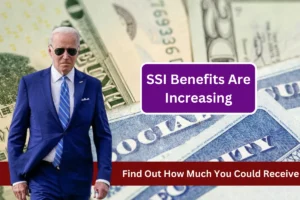If you qualify for Supplemental Security Income (SSI), watch your bank account as the Social Security Administration (SSA) will send a new SSI payment today. SSI recipients will receive $698 on average, but there are maximum payments available to eligible individuals and couples who meet established requirements.
What is SSI and Who Can Get It?
The Supplemental Security Income (SSI) program provides older adults and people with disabilities who have little to no income or resources a monthly federal base rate of up to $943 for individuals, $1,415 for couples, and an additional $472 for those who qualify for the essential person (EP) filing category.
On the other hand, the average monthly income for those under the age of 18 is $814, for those between the ages of 18 and 64, it is $742, and for those 65 years of age or older, it is $574.
SSI Payment and Medicaid
In most states, SSI recipients are instantly qualified for Medicaid, which offers necessary long-term care and assistance. Medicaid provides funding for services that assist people with disabilities to live in their homes and communities. These services include personal and attendant care. Medicaid also pays for services related to supportive housing, elevators, and wheelchairs.
It’s important to mention that Medicaid is usually not covered by private insurance since this treatment is quite expensive, except for the wealthiest individuals in the United States. Roughly 25% of SSI recipients received housing assistance in 2016,
while 52% of beneficiaries also received aid from the Supplemental Nutrition Assistance Program (SNAP), previously known as food stamps. Many states have increased the federal SSI benefit, reducing these extra payments over time.
The Growing Share of Children and Disabled Individuals
Older adults receiving SSI benefits have continuously decreased since the program was developed in 1974, primarily due to a decline in the number of recipients who meet the program’s increasingly strict income requirements.
Due in part to legislative changes in 1984 that broadened eligibility based on mental health disorders and a 1990 Supreme Court case that expanded the SSI disability criteria for children, the percentage of adults and children with disabilities receiving SSI has increased.
Moreover, a legislative amendment in 1996 limited eligibility for immigrants and children, which foresees that the percentage of Americans receiving SSI will stay constant at 2.15 percent, having decreased in recent years. It is also forecasted that the proportion of recipients of SSI from particular age groups will either remain unchanged or, in the case of older individuals, continue to decline.
SSI Payment: Confirmed Full-Year Schedule for 2024
After today’s payment is completed, recipients will receive their next SSI payment on the 1st of May. Below, you can find all the upcoming SSI payments following the Social Security Administration’s (SSA) schedule. To get further details about Social Security payments, please visit the official benefits payment schedule for 2024.
SSI Payment Schedule
| SSI Payment Date | SSI Payment Day |
|---|---|
| March 1st | Friday |
| April 1st | Monday |
| May 1st | Wednesday |
| June 1st | Friday |
| July 1st | Monday |
| August 1st | Thursday |
| September 1st | Friday |
| October 1st | Tuesday |
| November 1st | Friday |
| December 1st | Friday |
The Value of Receiving a Monthly SSI Payment
Approximately three-fourths of the federal poverty threshold is reached by a single person on SSI benefits before any state supplement and without income deductions. Therefore, even though SSI by itself is insufficient to raise an independent living person beyond the poverty level, it does diminish hardship and the requirement for family support.
However, even with their SSI benefits, around half of all beneficiaries in 2016 had earnings below the federal poverty level. Benefits are not received by a large number of additional elderly or disabled persons who are in need, including those whose legal immigration status is impacted by the 1996 eligibility restrictions.
1. What is the average SSI payment?
The average SSI payment is $698, but it varies based on eligibility and specific circumstances.
2. Who qualifies for SSI?
SSI is for older adults and people with disabilities who have little to no income or resources.
3. How does SSI interact with Medicaid?
In most states, SSI recipients are automatically eligible for Medicaid, which helps cover long-term care and assistance.
4. Has the number of SSI recipients changed over time?
Yes, the number of older adults receiving SSI has decreased, while the percentage of adults and children with disabilities receiving SSI has increased.
5. What is the SSI payment schedule for 2024?
The payments are made on the 1st of each month, with specific dates outlined in the SSI payment schedule for 2024.




